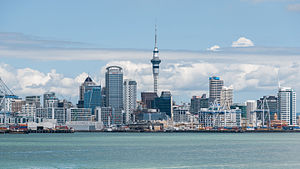Creating sustainable futures/CSF103/Framing/Strategic goals
The vision for Auckland is “The world’s most liveable city”. The Auckland Plan then identifies seven high level objectives, or strategic outcomes, that cluster initiatives and activities aimed at making Auckland the world’s most liveable city. It’s an ambitious vision, stated very simply, that involves an incredibly complex web of activity.
Carpet manufacturer and sustainability pioneer Interface has framed its vision alongside its Mission Zero commitment,
“To be the first company that, by its deeds, shows the entire industrial world what sustainability is in all its dimensions: People, process, product, place and profits — by 2020 — and in doing so we will become restorative through the power of influence.”
This vision has inspired the people at Interface since 1995 and helped shaped the company’s achievements that make it one of the most respected and recognised sustainability leaders in the world.
Interface used the Natural Step framework to develop a sustainability strategy that could help focus the company’s efforts to achieve this ambitious vision. It comprised seven high-level goals that Ray Anderson often called the seven fronts of Mount Sustainability:
- Eliminate Waste: Eliminating all forms of waste in every area of the business
- Benign Emissions: Eliminating toxic substances from products, vehicles and facilities
- Renewable Energy: Operating facilities with renewable energy sources, solar, wind, landfill gas, biomass, low impact hydroelectric
- Closing the Loop: Redesigning processes and products to close the technical loop using recovered and bio-based materials
- Resource Efficient Transportation: Transporting people and products efficiently to reduce waste and emissions
- Care for People: Creating a culture that integrates sustainability principles and improves people lives and livelihoods
- Redesign Commerce: Creating a new business model that demonstrates and support the value of sustainability-based commerce
The real power and strength of these goals is that because they described ultimate success, as defined by a robust scientific understanding of sustainability, they have remained constant over time. This provides a stable basis for sustainability programmes and investment, and enables a consistent set of performance metrics.
In 2016 Interface updated its high-level sustainability strategy for the first time since 1995. Seeing that the 2020 goals were actually within its grasp, the company recognised that ‘sustainability’, or zero impact, was no longer enough and decided that it needed to work towards a net positive, restorative mission. The fresh mission is called ‘Climate Take Back’ and entails four goals that are shaped around the Natural Step’s sustainability principles:
Only take what can be replaced See carbon as a resource Restore nature’s proven ability to restore Revolutionise our industries
Specifically, Climate Take Back includes four key commitments, as discussed in an article by Joel Makower ‘Two steps forward: Inside Interface’s bold new mission to achieve Climate Take Back’: We will bring carbon home and reverse climate change. We will create supply chains that benefit all life. We will make factories that are like forests. We will transform dispersed materials into products and goodness.
